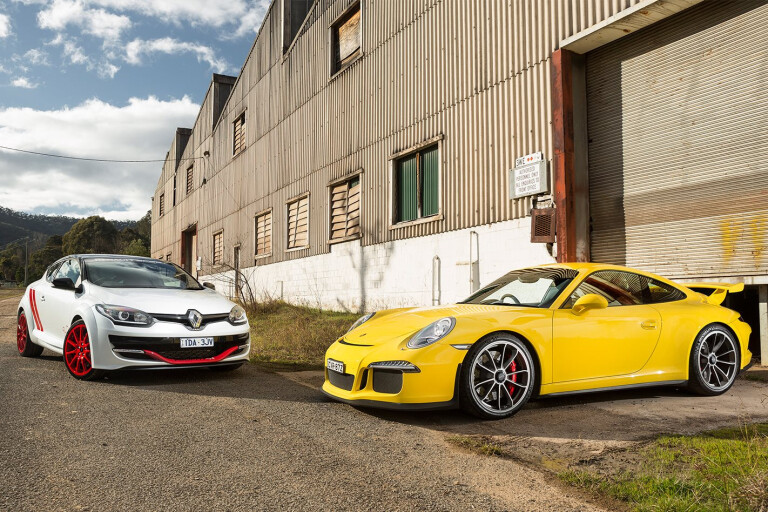
Gravity’s a funny thing – it’s such a forgettable sensation, but yet even now as you read this, it’s gently crushing you. And without it, we wouldn’t have any need for, well, bras, rocket scientists, legs, and a whole lot of other things. But we’re getting carried away.
There’s another all-powerful, all-pervading force that works a silent magic on those who like cars. It’s easiest felt when in the presence of something with fixed-back racing seats and no sound deadening. But still wearing number plates.
No matter your four-wheeled tastes, you’d be checking in to the local lunatic asylum if you turned down a blast in something like a Ferrari 458 Speciale, McLaren 675 LT, Aston Martin Vantage GT12, any Caterham or, of course, Porsche’s 911 GT3. All wear the whole ‘add lightness’ thing on their sleeves (or on their doors, often as gaudy stickers). But for good reason.
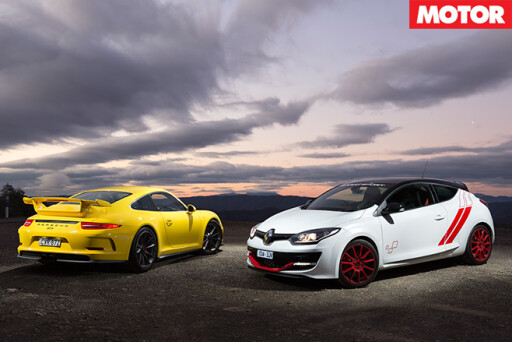 Obviously lightness is very good when it comes to performance cars. Ditch the kilos and gain performance, but you also get a mysterious, warm and fuzzy feeling of lightness. Unfortunately adding lightness also often adds cost – a lot of it.
Obviously lightness is very good when it comes to performance cars. Ditch the kilos and gain performance, but you also get a mysterious, warm and fuzzy feeling of lightness. Unfortunately adding lightness also often adds cost – a lot of it.
So Renault had us taking notice when it first announced the Megane Trophy-R. At $61,990, Renault had either made a budget 911 GT3; or, at $18K more than an RS265, were seriously taking the piss.
Fortunately it’s more a case of the former than the latter. In fact, bail a MOTOR road-tester up and it won’t take half a bottle of red for them to confess their love for the little Trophy-R. The best front-driver we’ve driven, at least most of us will say. Yep, that good.
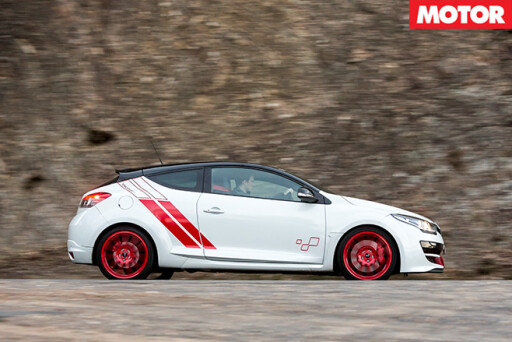 It’s funny that all it took over the RS275 was ditching a bunch of interior parts, adding better dampers and stickier tyres. Compared to that little brother version, which weighs 1381kg, Renault’s pulled nearly 100kg out – rear seat, gone, saving 20kg.
It’s funny that all it took over the RS275 was ditching a bunch of interior parts, adding better dampers and stickier tyres. Compared to that little brother version, which weighs 1381kg, Renault’s pulled nearly 100kg out – rear seat, gone, saving 20kg.
Same for most of the sound deadening (-18kg), while swapping the stock seats for polycarbonate fixed-back items saves 22kg. Renault then ditches rear wiper (-1kg), air-con and stereo (-10kg). Interestingly, the Trophy-R is 146kg lighter than a 911 GT3.
Power outputs from the turbo 2.0-litre are unchanged, 201kW and 360Nm, but Renault’s fitted fancy Ohlins Road & Track dampers and Michelin Pilot Sport Cup 2 tyres – semi-slicks, basically, and the same tyres on this here Porsche.
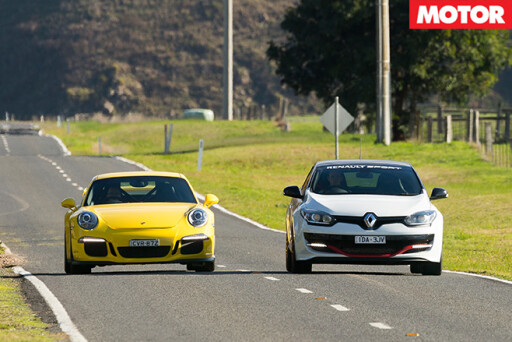 To more cynical readers, we know what you’re grunting: we can’t really be serious comparing a Megane to a car nearly five times the price, surely? Well, yes and no.
To more cynical readers, we know what you’re grunting: we can’t really be serious comparing a Megane to a car nearly five times the price, surely? Well, yes and no.
It’s not really a comparison, per se. Thing is, there’s something about the 911 GT3, 458 Speciale et al, that makes them so mind-blowing, and we suspect it’s got a lot to do with the whole track-car-with-numberplates thing. The Trophy-R would like to think it shares the same philosophy, so is any of this feeling available in Renault’s angry bum-dragger? By extension, if so, that means it’s available to financial mortals.
Tyres and rear-seat scaffolding aside, nothing says ‘take me to a racetrack’ like a steering wheel dipped in Alcantara, which is the case in both Trophy-R and GT3. Well, nothing except a DIN pocket where the stereo should be. Welcome to the Trophy-R’s interior.
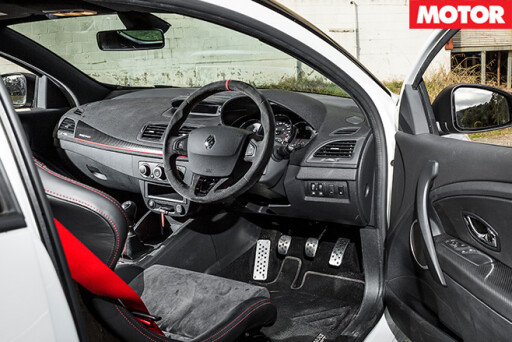 Aussie owners will become habitual headphone carriers – that is, unless they opt to put the stereo and air-con back in. A smart move, if we’re asked. The Porsche smartly keeps its stereo, air-con and even has sat-nav. It’s even quite nice to drive around town. Yes, there’s a slight edge to the ride, and you’ll be buying earplugs ahead of any road trips (noisy tyres), but otherwise, it’s perfectly liveable.
Aussie owners will become habitual headphone carriers – that is, unless they opt to put the stereo and air-con back in. A smart move, if we’re asked. The Porsche smartly keeps its stereo, air-con and even has sat-nav. It’s even quite nice to drive around town. Yes, there’s a slight edge to the ride, and you’ll be buying earplugs ahead of any road trips (noisy tyres), but otherwise, it’s perfectly liveable.
The Trophy-R is much the same, too, leading us to wonder what has happened to track cars like this. They should be rattling the fillings out of our teeth, and giving us tinnitus – track day cars have grown up, it seems.
Mod-con grievances quickly dissolve on the first couple of corners in either car. By then, you would have already noticed the GT3 idles with a sound like there’s bits of gravel in the crankcase.
Apparently a lumpy, ever-so-slightly impatient idle was engineered into the GT3’s 3.8-litre flat six, because it shouldn’t sound so behaved you forget 350kW and 440Nm are champing at the bit.
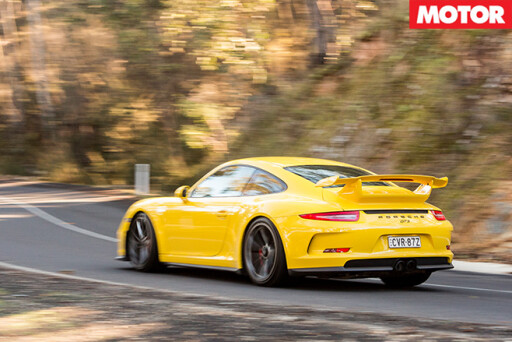 And, yes, that’s not the clutch pedal stuck to the floor, that’s the footrest. But first gear in the GT3, even if it does live in a PDK ’box, is one of those ‘things’.
And, yes, that’s not the clutch pedal stuck to the floor, that’s the footrest. But first gear in the GT3, even if it does live in a PDK ’box, is one of those ‘things’.
Of course there’s plenty of pep no matter the revs, but it’s more linear than alike to getting slammed in the boot by a b-double (the turbo effect). In fact, after five or so minutes of having a little go in the GT3, you could forgive yourself for thinking, that it? Then you realise you’ve been changing gears at 7000rpm.
It’s understandable; even at that rpm, there’s no shortage of noise and intensity – a distinct, flat-six bark like a Carrera Cup car, but one that knows manners. But everything up to 7000rpm is the opening act, beyond that is the main event.
 It’s at 9000rpm that you’re thinking swearwords to yourself, wondering if you’ve just woken up some sort of wild animal. Not just the noise steps up another level, but the power, which makes sense given the full fat 350kW arrives at 8250rpm.
It’s at 9000rpm that you’re thinking swearwords to yourself, wondering if you’ve just woken up some sort of wild animal. Not just the noise steps up another level, but the power, which makes sense given the full fat 350kW arrives at 8250rpm.
You don’t quite get used to revving it out that far, but when you half do, you realise, by god, the GT3 is fast. The front-end is scalpel sharp, the steering alert yet the weighting spot-on. The brakes feel stunningly powerful, yet you always know how much is left.
And the GT3 encourages us to dust off the old “like it’s on rails” expression, because you’ll be left gaga-ing at just how much grip there is – corner entry speed is as much about how big your cojones are. We suspect it has a lot to do with the all-wheel steering; in the slow stuff particularly, the GT3 is particularly eager to turn.
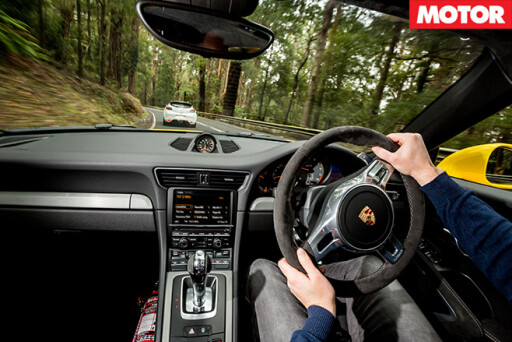 The limit, meanwhile, is so high, you’ll feel deserving of some sort of trophy should you get anywhere near it. To some extent, there is too much grip for the road. And yet still, the 911 GT3 chassis doesn’t break a sweat – it feels like it was designed for slicks.
The limit, meanwhile, is so high, you’ll feel deserving of some sort of trophy should you get anywhere near it. To some extent, there is too much grip for the road. And yet still, the 911 GT3 chassis doesn’t break a sweat – it feels like it was designed for slicks.
In some ways the GT3’s best trick is how it focuses the attention back on you. If you’re not deadly smooth, you’ll know. It’s as intimidating as it is educating, yet all the while it’s easy to drive fast, and never scary; it's never going to shout “surprise!” mid-corner, at least on the road.
So you could call it a wee comedown getting into the bulbous Trophy-R after the GT3. One claims 0-100km/h in 3.5 seconds, the other 5.8. Says it all, but not exactly.

The Renault still sounds good, too, particularly for a turbo four-cylinder (generally not the most aurally satisfying engine variety). You can hear rocks tickling the underside of the car, which has a certain appeal, but the lack of sound deadening does more to let in engine noise, an angry induction hiss with a ballsy exhaust and the odd pop on upchange. There’s a certain feral-ness to a Trophy-R at full throttle.
On road the Trophy-R has its suspension pretty well sorted. Over bumps that might otherwise upset a normal RS275, the Trophy-R simply rocks and bobs, encouraging you to keep your foot in it. And there’s plenty of grip on offer.
 Some care is needed when punting a Trophy-R hard, at least on the first date, as it likes to use up all its rear grip first. But you’ll be happy-clapping if you like a playful rear end in your front-driver. The Trophy-R certainly has no shortage of that.
Some care is needed when punting a Trophy-R hard, at least on the first date, as it likes to use up all its rear grip first. But you’ll be happy-clapping if you like a playful rear end in your front-driver. The Trophy-R certainly has no shortage of that.
At the end of the day, on the same road, the Trophy-R and 911 GT3 are almost worlds apart in how they drive. One’s an LSD-equipped hot hatch scrabbling for front grip and keen to dance, the other is a planted supercar that’ll blow your mind with its sheer speed. But what both cars have in common is an eagerness to interact, a certain honesty in the way they drive that makes you feel safe to go fast.
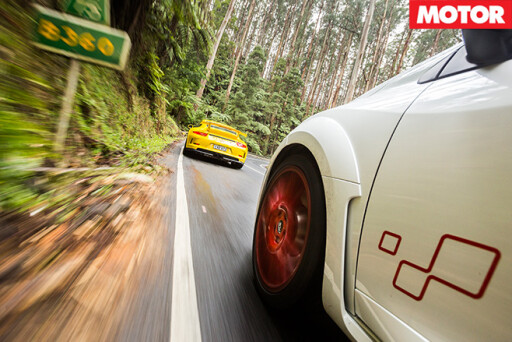 Perhaps it’s the snug seats plugging your bum right into the chassis, or the honest steering in either. Surely a lot of it comes down to the rubber – both cars are on Michelin Pilot Sport Cup 2s – which, when up to temp, dish up tonnes of grip yet are super-friendly.
Perhaps it’s the snug seats plugging your bum right into the chassis, or the honest steering in either. Surely a lot of it comes down to the rubber – both cars are on Michelin Pilot Sport Cup 2s – which, when up to temp, dish up tonnes of grip yet are super-friendly.
In some ways the Megane feels to have benefitted most from the weight saving efforts. It gives it a feeling of lightness that makes it keener on its feet; an RS275 feels pudgy by comparison. But most of all it gives you a taste of that feeling of lightness that’ll have you tearing out the back seat and trimming the rear vision mirror of your partner’s Corolla.
They’re worlds apart in speed, but the GT3 and Megane do behave in similar ways. Of course, both cars make you want to get out a Gregory’s and look up the nearest racetrack – and they create that feeling in equal measure.
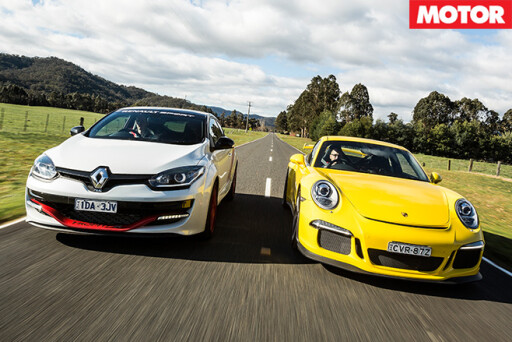 But it’s away from the driving you might find the most striking similarity. Driver’s door open, keys dangling in ignition, idling angrily, the GT3 and Trophy-R equally draw you in with an all-powerful force – a kind of gravity, you could almost say. Car people will get it.
But it’s away from the driving you might find the most striking similarity. Driver’s door open, keys dangling in ignition, idling angrily, the GT3 and Trophy-R equally draw you in with an all-powerful force – a kind of gravity, you could almost say. Car people will get it.
| PORSCHE 911 GT3 | MEGANE RS275 TROPHY-R | |
| Body | 2-door, 2-seat coupe | 3-door, 2-seat hatch |
| Drive | rear-wheel | front-wheel |
| Engine | 3799cc flat-6, DOHC, 24v | 1998cc inline-4, DOHC, 16v, turbocharger |
| Bore/stroke | 102.0 x 77.5mm | 82.7 x 93.0mm |
| Compression | 12.9:1 | 8.6:1 |
| Power | 350kW @ 8250rpm | 201kW @ 5500rpm |
| Torque | 440Nm @ 6250rpm | 360Nm @ 3000rpm |
| Power/weight | 245kW/tonne | 156kW/tonne |
| Transmission | 7-speed dual-clutch | 6-speed manual |
| Weight | 1430kg | 1284kg |
| Suspension(F) | struts, adaptive dampers, coil springs, anti-roll bar | struts, A-arms, coil springs, anti-roll bar |
| Suspension(R) | multi-links, adaptive dampers, coil springs, anti-roll bar | torsion beam, coil springs, anti-roll bar |
| L/W/H | 4545/1852/1269mm | 4320/1868/1422mm |
| Wheelbase | 2457mm | 2646mm |
| Tracks | 1551/1555mm (f/r) | 1546/1547mm (f/r) |
| Steering | electrically-assisted rack-and-pinion | electrically-assisted rack-and-pinion |
| Brakes(F) | 380mm ventilated discs, 6-piston calipers | 340mm ventilated discs, 4-piston calipers |
| Brakes(R) | 380mm ventilated discs, 4-piston calipers | 290mm solid discs, single-piston calipers |
| Wheels | 20.0 x 9.0-inch (f); 20.0 x 12.0-inch (r) | 19.0 x 8.25-inch (f/r) |
| Tyre Sizes | 245/35 R20 (f); 305/30 R20 (r) | 235/35 ZR19 (f/r) |
| Tyre | Michelin Pilot Sport Cup 2 | Michelin Pilot Sport Cup 2 |
| Price as tested | $313,490 | $61,990 |
| Pros | Grunt, grip, steering, noise... everything | Rorty engine; playful, friendly chassis; big fun |
| Cons | Tyres can be a little noisy. That's it, really | Road trips; gearchange; not sold on stickers |
| Star Rating | 5/5 | 4.5/5 |

COMMENTS